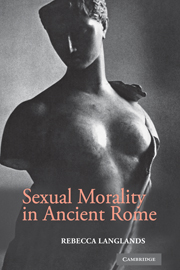Book contents
- Frontmatter
- Contents
- Acknowledgements
- Introduction
- Chapter 1 Sexual virtue on display I: the cults of pudicitia and honours for women
- Chapter 2 Traditional narratives and Livy's Roman history
- Chapter 3 Valerius Maximus: the complexities of past as paradigm
- Chapter 4 Subversive genres: testing the limits of pudicitia
- Chapter 5 Declamation: what part of ‘no’ do you understand?
- Chapter 6 Sexual virtue on display II: oratory and the speeches of Cicero
- Chapter 7 Imperial narratives, imperial interventions
- Conclusion
- Bibliography
- Subject index
- Index locorum
- References
Bibliography
Published online by Cambridge University Press: 22 September 2009
- Frontmatter
- Contents
- Acknowledgements
- Introduction
- Chapter 1 Sexual virtue on display I: the cults of pudicitia and honours for women
- Chapter 2 Traditional narratives and Livy's Roman history
- Chapter 3 Valerius Maximus: the complexities of past as paradigm
- Chapter 4 Subversive genres: testing the limits of pudicitia
- Chapter 5 Declamation: what part of ‘no’ do you understand?
- Chapter 6 Sexual virtue on display II: oratory and the speeches of Cicero
- Chapter 7 Imperial narratives, imperial interventions
- Conclusion
- Bibliography
- Subject index
- Index locorum
- References
- Type
- Chapter
- Information
- Sexual Morality in Ancient Rome , pp. 366 - 386Publisher: Cambridge University PressPrint publication year: 2006



